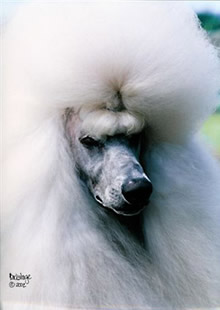About Sebaceous Adenitis
 Sebaceous Adenitis (SA) is a hereditary skin disease in which the sebaceous glands become inflamed, often leading to progressive loss of hair. The disease is primarily seen in Standard Poodles, Akitas, and Samoyeds, although there have been reported cases in a number of other breeds and mixed breeds as well. The disease can develop in a wide age range, with age of onset documented as early as 1 year and as late as 12 years. Males and females appear to be affected equally. The exact mode of inheritance is unknown.
Sebaceous Adenitis (SA) is a hereditary skin disease in which the sebaceous glands become inflamed, often leading to progressive loss of hair. The disease is primarily seen in Standard Poodles, Akitas, and Samoyeds, although there have been reported cases in a number of other breeds and mixed breeds as well. The disease can develop in a wide age range, with age of onset documented as early as 1 year and as late as 12 years. Males and females appear to be affected equally. The exact mode of inheritance is unknown.
SA can be difficult as the symptoms vary by breed, the symptoms are similar to those of other diseases such as hypothyroidism or allergies, and the disease can vary greatly in its severity. Visible symptoms include excessive dandruff or scaling, hair loss, lesions, a musty odor, and even secondary skin infections. On the other hand, dogs affected with SA can be subclinical and show no outward signs of the disease.
There is no DNA test available to genotypically detect SA. Currently, diagnosis is based on skin biopsy samples, and unfortunately the current screening method may result in false negatives.
Because the age of onset varies, and since this is only a phenotypic test reflecting a point in time, retesting is recommended every 1 to 2 years for dogs used in breeding programs.
The Sebaceous Adenitis Exam
The minimum age for registration in the OFA SA database is 12 months.
The attending veterinarian examines the dog for clinical symptoms of the disease and notes any findings on the application form. A minimum of two 6mm punch biopsy samples are taken from the skin of the dog's neck between the top of the head and the withers. If there are areas of scaling and hair loss, samples should be taken from those areas.
To procure the sample, a local anesthetic such as lidocaine may be used. The area should not be scrubbed or otherwise cleaned, however gentle clipping of the area may be necessary. The specimen should be placed in a crush proof container containing formalin in preparation for shipment to the lab.
In preparing the dog, keep the hair coat clean, groom gently, and use good flea control practices. Flea bites and other irritations form matted hair coats or vigorous grooming can cause mild inflammation and result in equivocal test results.
To avoid unlikely possibility of irritation from shampooing or topical flea control, do not shampoo the dog 2 weeks prior to the SA biopsy sampling, and make sure the biopsy samples are taken a minimum of 3 inches away from topical flea control product application sites.
The sample, the completed OFA application, and both the lab fee and OFA fee are shipped to any of the approved dermapathology labs for evaluation. Owners and veterinarians procuring the sample are urged to contact the lab prior to shipping for current fees and any special lab specific instructions. The lab results are classified as either:
- Normal - No evidence Of Sebaceous Adenitis at the time of the evaluation
- Affected
- Subclinically Affected – the dog has normal skin and hair coat, but has biopsy evidence of SA
- Equivocal - some inflammation is present, but the cause cannot be determined – retesting recommended in 3 to 6 months
The lab results and final diagnosis are returned to the OFA and to the owner.
** Please call the lab for current fee schedule and for lab specific instructions **

 Sebaceous Adenitis (SA) is a hereditary skin disease in which the sebaceous glands become inflamed, often leading to progressive loss of hair. The disease is primarily seen in Standard Poodles, Akitas, and Samoyeds, although there have been reported cases in a number of other breeds and mixed breeds as well. The disease can develop in a wide age range, with age of onset documented as early as 1 year and as late as 12 years. Males and females appear to be affected equally. The exact mode of inheritance is unknown.
Sebaceous Adenitis (SA) is a hereditary skin disease in which the sebaceous glands become inflamed, often leading to progressive loss of hair. The disease is primarily seen in Standard Poodles, Akitas, and Samoyeds, although there have been reported cases in a number of other breeds and mixed breeds as well. The disease can develop in a wide age range, with age of onset documented as early as 1 year and as late as 12 years. Males and females appear to be affected equally. The exact mode of inheritance is unknown.


